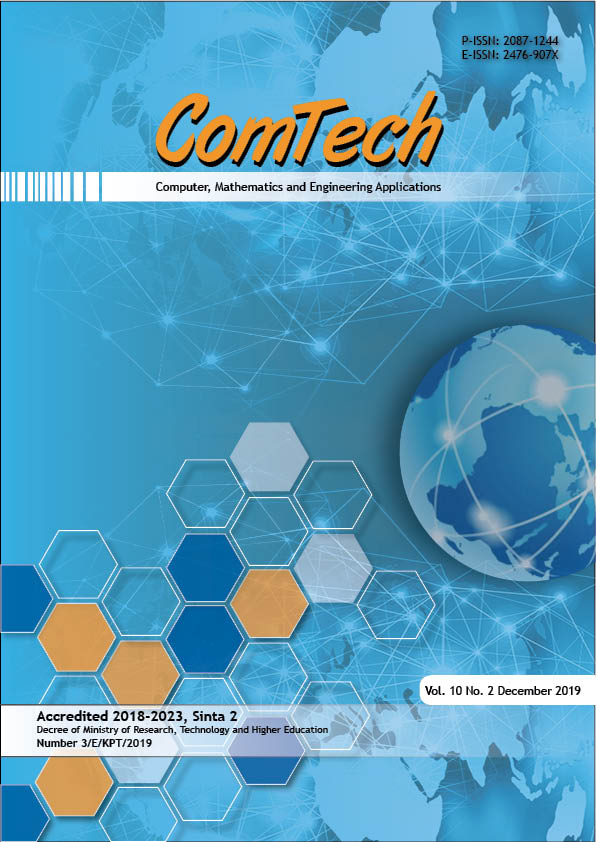Dynamical System of the Mathematical Model for Tuberculosis with Vaccination
DOI:
https://doi.org/10.21512/comtech.v10i2.5686Keywords:
dynamical system, mathematical model, tuberculosis, vaccinationAbstract
This research focused on the modification of deterministic mathematical models for tuberculosis with vaccination. It also aimed to see the effect of giving the vaccine. It was done by adding vaccine compartments to people who were given the vaccine in the susceptible compartment. The population was divided into nine different groups. Those were susceptible individuals (S), vaccine (V), new latently infected (E1), diagnosed latently infected (E2), undiagnosed latently infected (E3), undiagnosed actively infected (l), diagnosed actively infected with prompt treatment (Dr), diagnosed actively infected with delay treatment (Dp), and treated (T). Basic reproduction number was constructed using next-generation matrix. Sensitivity analysis was also conducted. The results show that the model comprises two equilibriums: diseasefree equilibrium (T0) and endemic equilibrium (T*). It also shows that there is a relationship between R0 and two equilibriums. Moreover, the disease-free equilibrium point is asymptotically stable local when it is R0 < 1. Then, the disease-endemic equilibrium point is asymptotically stable local when it is R0 > 1. Furthermore, the parameters of β, Ï, and γ are the most important parameter.
References
Al-Darraji, H. A. A., Altice, F. L., & Kamarulzaman, A. (2016). Undiagnosed pulmonary tuberculosis among prisoners in Malaysia: An overlooked risk for tuberculosis in the community. Tropical Medicine and International Health, 21(8), 1049-1058. https://doi.org/10.1111/tmi.12726
Anderson, R. M., & May, R. M. (1991). Infectious diseases of humans: Dynamics and control. New York: Oxford University Press.
Aparicio, J., & Casstillo-Chavez, C. (2009). Mathematical modelling of tuberculosis epidemics. Mathematical Biosciences and Engineering, 6(2), 209-237. https://doi.org/10.3934/mbe.2009.6.209
Apriliani, V. (2016). Sistem dinamik model penyebaran penyakit tuberkulosis dengan dua kelompok populasi terinfeksi (Master’s thesis). Institut Pertanian Bogor.
Castillo-Chavez, C., & Song, B. (2004). Dynamical models of tuberculosis and their applications. Mathematical Biosciences and Engineering, 1(2), 361-404. https://doi.org/10.3934/mbe.2004.1.361
Chitnis, N., Hyman, J. M., & Cushing, J. M. (2008). Determining important parameters in the spread of malaria through the sensitivity analysis of a mathematical model. Bulletin of Mathematical Biology, 70(5), 1272-1296. https://doi.org/10.1007/s11538-008-9299-0
Dushoff, J., Huang, W., & Castillo-Chavez, C. (1998). Backwards bifurcations and catastrophe in simple models of fatal diseases. Journal of Mathematical Biology, 36(3), 227-248. https://doi.org/10.1007/s002850050099
Edelstein-Keshet, L. (2005). Mathematical models in biology. Philadelphia: Society for Industrial and Applied Mathematics.
Egonmwan, A. O., & Okuonghae, D. (2019). Analysis of a mathematical model for tuberculosis with diagnosis. Journal of Applied Mathematics and Computing, 59(1–2), 129-162. https://doi.org/10.1007/s12190-018-1172-1
Esmail, H., Barry, C. E., Young, D. B., & Wilkinson, R. J. (2014). The ongoing challenge of latent tuberculosis. Philosophical Transactions of the Royal Society B: Biological Sciences, 369, 1-14. https://doi.org/10.1098/rstb.2013.0437
Kalu, A. U., & Inyama, S. C. (2012). Mathematical model of the role of vaccination and treatment on the transmission dynamics of Tuberculosis. Gen. Math. Notes, 11(1), 10-23.
Kermack, W.O., & McKendrick, A.G. (1927). A contribution to the mathematical theory of epidemics. Proceedings of The Royal Society A: Mathematical, Physical and Engineering Sciences, 115(772),700-721. https://doi.org/10.1098/rspa.1927.0118
Lawn, S. D., & Zumla, A. I. (2011). Tuberculosis. The Lancet., 378 (9785), 57-72. https://doi.org/10.1016/S0140-6736(10)62173-3
Nainggolan, J., Supian, S., Supriatna, A. K., & Anggriani, N. (2013). Mathematical model of tuberculosis transmission with reccurent infection and vaccination. Journal of Physics: Conference Series, 423(1), 1-8. https://doi.org/10.1088/1742-6596/423/1/012059
Okuonghae, D. (2013). A mathematical model of tuberculosis transmission with heterogeneity in disease susceptibility and progression under a treatment regime for infectious cases. Applied Mathematical Modelling, 37(10–11), 6786-6808. https://doi.org/10.1016/j.apm.2013.01.039
Okuonghae, D., & Ikhimwin, B. O. (2016). Dynamics of a mathematical model for tuberculosis with variability in susceptibility and disease progressions due to difference in awareness level. Frontiers in Microbiology, 6, 1-23. https://doi.org/10.3389/fmicb.2015.01530
Okuonghae, D., & Omosigho, S. E. (2011). Analysis of a mathematical model for tuberculosis: What could be done to increase case detection. Journal of Theoretical Biology, 269(1), 31-45. https://doi.org/10.1016/j.jtbi.2010.09.044
Robinson, J. C. (2004). An introduction to ordinary differential equations (Cambridge texts in applied mathematics). Cambridge University Press.
Roni, T. P. (2011). Kestabilan lokal bebas penyakit model epidemi SEIR dengan kumpulan infeksi pada periode laten. Padang: Politeknik Negeri Padang.
Side, S., Sanusi, W., & Setiawan, N. F. (2016). Analisis dan simulasi model SITR pada penyebaran penyakit Tuberkulosis di Kota Makassar. Jurnal Sainsmat, 5(2), 191-204.
Trauer, J. M., Denholm, J. T., & McBryde, E. S. (2014). Construction of a mathematical model for tuberculosis transmission in highly endemic regions of the Asia-Pacific. Journal of Theoretical Biology, 358(October), 74-84. https://doi.org/10.1016/j.jtbi.2014.05.023
World Health Organization (WHO). (2018). Global tuberculosis report 2018. Retrieved from https://www.who.int/tb/publications/global_report/en/
Downloads
Published
How to Cite
Issue
Section
License
Authors who publish with this journal agree to the following terms:
a. Authors retain copyright and grant the journal right of first publication with the work simultaneously licensed under a Creative Commons Attribution License - Share Alike that allows others to share the work with an acknowledgment of the work's authorship and initial publication in this journal.
b. Authors are able to enter into separate, additional contractual arrangements for the non-exclusive distribution of the journal's published version of the work (e.g., post it to an institutional repository or publish it in a book), with an acknowledgment of its initial publication in this journal.
c. Authors are permitted and encouraged to post their work online (e.g., in institutional repositories or on their website) prior to and during the submission process, as it can lead to productive exchanges, as well as earlier and greater citation of published work.
 USER RIGHTS
 All articles published Open Access will be immediately and permanently free for everyone to read and download. We are continuously working with our author communities to select the best choice of license options, currently being defined for this journal as follows:




















